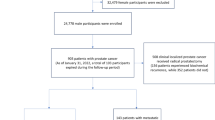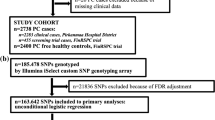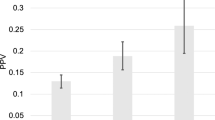Abstract
Previous studies have reported that adult height is positively associated with the risk of prostate cancer. The authors carried out a population-based case–control study involving 317 prostate cancer cases and 480 controls to further investigate the possibility that height is more strongly associated with advanced, compared with localized forms of this disease. Since the inherited endocrine factors, which in part determine height attained during the growing years, may influence the risk of familial prostate cancer later in life, the relationship with height was also investigated for familial versus sporadic prostate cancers. Adult height was not related to the risk of localized prostate cancer, but there was a moderate positive association between increasing height and the risk of advanced cancer (relative risk (RR) = 1.62; 95% confidence interval (CI) 0.97–2.73, upper versus lowest quartile, P -trend = 0.07). Height was more strongly associated with the risk of prostate cancer in men with a positive family history compared with those reporting a negative family history. The RR of advanced prostate cancer for men in the upper height quartile with a positive family history was 7.41 (95% CI 1.68–32.67, P -trend = 0.02) compared with a reference group comprised of men in the shortest height quartile with a negative family history. Serum insulin-like growth factor-1 levels did not correlate with height amongst men with familial or sporadic prostate cancers. These findings provide evidence for the existence of growth-related risk factors for prostate cancer, particularly for advanced and familial forms of this disease. The possible existence of inherited mechanisms affecting both somatic and tumour growth deserves further investigation. © 2000 Cancer Research Campaign
Similar content being viewed by others
Article PDF
Change history
16 November 2011
This paper was modified 12 months after initial publication to switch to Creative Commons licence terms, as noted at publication
References
Andersson S-O, Baron J, Bergstrom R, Lindgren C, Wolk A and Adami H-O (1996) Lifestyle factors and prostate cancer risk: a case–control study in Sweden. Cancer Epidemiol Biomarkers Prev 5: 509–513
Andersson S-O, Wolk A, Bergstrom R, Adami H-O, Engholm G, Englund A and Nyren O (1997) Body size and prostate cancer: a 20-year follow-up study among 135 006 Swedish construction workers. J Natl Cancer Inst 89: 385–389
Chan JM, Stampfer MJ, Giovannucci E, Gann PH, Ma J, Wilkinson P, Hennekens CH and Pollak M (1998) Plasma insulin-like growth factor-1 and prostate cancer risk: a prospective study. Science 279: 563–566
Cohen P, Peehl DM, Lamson N and Rosenfield RG (1991) Insulin-like growth factors (IGFs), IGF receptors and IGF binding proteins in primary cultures of prostate epithelial cells. J Clin Endocrinol Metab 73: 401–407
Cohen P, Peehl DM, Graves HCB and Rosenfield RG (1994) Biological effects of prostate specific antigen (PSA) as an IGF binding protein-3 (IGFBP-3) protease. J Endocrinol 142: 407–415
Ekbom A, Hsieh CC, Lipworth L, Wolk A, Ponten J, Adami H-O and Trichopoulos D (1996) Perinatal characteristics in relation to incidence of and mortality from prostate cancer. Br Med J 313: 337–341
Gann PH, Hennekens CH, Ma J, Longcope C and Stampfer MJA (1996) A prospective study of sex hormone levels and risk of prostate cancer. J Natl Cancer Inst 88: 1118–1126
Giovannucci E (1995) Epidemiological characteristics of prostate cancer. Cancer 75: 1766–1777
Giovannucci E, Rimm EB, Stampfer MJ, Colditz GA and Willet WC (1997) Height, body weight and risk of prostate cancer. Cancer Epidemiol Biomarkers Prev 6: 557–563
Gluckman PD, Johnson-Barret TJ, Butler J, Edgar BW and Gunn TR (1983) Studies of insulin-like growth factors-I and -II by specific radioligand assays in umbilical cord blood. Clin Endocrinol 19: 405–413
Goodman-Gruen D and Barrett-Connor E (1997) Epidemiology of insulin-like growth factor-1 in men and women. Am J Epidemiol 145: 970–976
Hebert PR, Ajani U, Cook NR, Lee I, Chan KS and Hennekens CH (1997) Adult height and incidence of cancer in male physicians (United States). Cancer Causes Control 8: 591–597
Johnston R (1983). A Revision of Socio-economic Indices for New Zealand, New Zealand Council for Educational Research: Wellington
Juul A, Dalgaard P, Blum WF, Bang P, Hall K and Michaelson KF (1995) Serum levels of insulin-like growth factor (IGF)-binding protein-1 (IGFBP-3) in healthy infants, children, and adolescents: the relation to IGF-1, IGF-II, IGFBP-2, age, sex, body mass index, and pubertal maturation. J Clin Endocrinol Metab 80: 2534–2542
Keenam BS, Richards GE, Ponder SW, Dakkas JS, Nagamani M and Smith ER (1993) Androgen-stimulated pubertal growth: the effects of testosterone and dihydrotestosterone on growth hormone and insulin-like growth factor-1 in the treatment of short stature and delayed puberty. J Clin Endocrinol Metab 76: 996–1001
Le Marchand L, Kolonel LN, Wilkins LR, Myers BC and Hirohata T (1994) Animal fat consumption and prostate cancer: a prospective study in Hawaii. Epidemiology 5: 276–282
Mantzoros CS, Tzonou A, Signorello LB, Tricopoulos D and Adami H-O (1997) Insulin-like growth factor-1 in relation to prostate cancer and benign prostatic hyperplasia. Br J Cancer 76: 1115–1118
Millar WJ (1986) Distribution of body weight and height: comparison of estimates based upon self-reported and observed measures. J Epidemiol Comm Hlth 40: 319–323
Palta M, Prineas RJ, Berman R and Hannan P (1982) Comparison of self-reported and measured height and weight. Am J Epidemiol 115: 223–230
Rajah R, Valentinis B and Cohen P (1997) Insulin-like growth factor (IGF)-binding protein-3 induces apoptosis and mediates the effects of transforming growth factor-beta 1 on programmed cell death through a p53- and IGF-independent mechanism. J Biol Chem 272: 12181–12188
Smith JR, Freije D, Carpten JD, Gronberg H, Xu J and Isaacs SD (1996) A genome-wide search reveals a major susceptibility locus for prostate cancer on chromosome 1. Science 274: 1371–1373
Stewart AW, Jackson RT, Ford MA and Beaglehole R (1987) Underestimation of relative weight by use of self-reported height and weight. Am J Epidemiol 125: 122–126
Tiblin G, Eriksoon S, Cnattingius S and Ekbom A (1995) High birthweight as a predictor of prostate cancer risk. Epidemiology 6: 423–424
Xu J, Myers D, Freije D, Isaacs S, Wiley K and Nusskern D (1998) Evidence for a prostate cancer susceptibility locus on the X chromosome. Nat Genet 20: 175–179
Author information
Authors and Affiliations
Rights and permissions
From twelve months after its original publication, this work is licensed under the Creative Commons Attribution-NonCommercial-Share Alike 3.0 Unported License. To view a copy of this license, visit http://creativecommons.org/licenses/by-nc-sa/3.0/
About this article
Cite this article
Norrish, A., McRae, C., Holdaway, I. et al. Height-related risk factors for prostate cancer. Br J Cancer 82, 241–245 (2000). https://doi.org/10.1054/bjoc.1999.0906
Received:
Revised:
Accepted:
Published:
Issue date:
DOI: https://doi.org/10.1054/bjoc.1999.0906
Keywords
This article is cited by
-
Height, selected genetic markers and prostate cancer risk: results from the PRACTICAL consortium
British Journal of Cancer (2017)
-
Height and risk of prostate cancer in the prostate, lung, colorectal, and ovarian cancer screening trial
British Journal of Cancer (2009)
-
Body size and composition and prostate cancer risk: systematic review and meta-regression analysis
Cancer Causes & Control (2006)
-
Glycemic index in chronic disease: a review
European Journal of Clinical Nutrition (2002)



